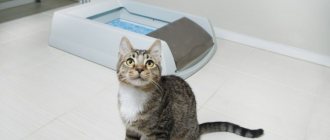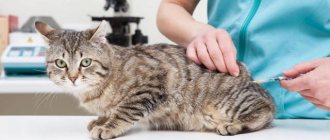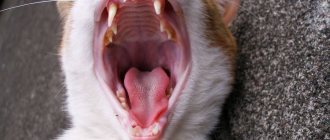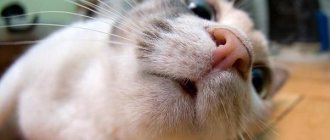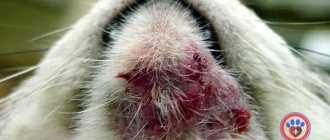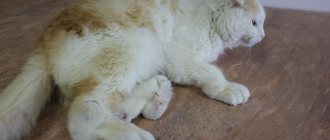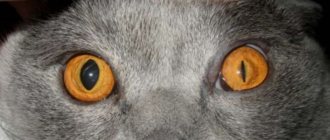We love cats for their sensitivity and emotional responsiveness, which they generously share with loving and caring owners. But it is precisely these qualities of our pets that can cause harm to themselves.
A cat's sensitivity makes it vulnerable to stress, and with prolonged or regular exposure to stress factors, dysfunction of the central nervous system can develop. One of the most common neurotic disorders in cats is obsessive-compulsive disorder. It is important to recognize this condition in a timely manner in order to begin treatment without delay. And it is equally important to understand the causes of neuroses in order to prevent their development.
Common neuralgic diseases
There are many pathologies of the central nervous system and peripheral parts. Often, disorders are associated with factors that disrupt the animal’s usual rhythm of life. Failures can occur when changing place of residence or owners, when suddenly switching to other foods, too noisy events with a large number of guests, etc. There are also illnesses that are a consequence of injuries, infections, and various diseases. Cats can be diagnosed with:
- increased aggressiveness;
- neurotic conditions;
- cerebrovascular accident;
- discopathy;
- meningoencephalitis;
- concussion;
- loss of mobility.
Aggression not associated with natural physiological periods is treated with hormonal therapy. Sterilization and castration may be prescribed. If the attack appears suddenly, the animal urgently needs to be shown to a doctor, it could be rabies.
The main cause of neurotic conditions is stress. They can be expressed both in the form of hysterics, aggression, and in depression, lethargy, and anorexia. The main treatment is to eliminate the provoking factor.
Cats, like people, can experience strokes and heart attacks. Cerebral circulation disorders can be a consequence of ischemia, blockage of blood vessels with blood clots.
After injuries, discopathy can develop, in which the position of the vertebrae is disrupted, leading to paralysis, paresis, and involuntary discharge of urine and feces.
Meningoencephalitis can develop due to viral infections. The disease can be quickly treated if diagnosed in a timely manner. It is more difficult to cope with a bacterial type disorder. Often it leaves consequences that cannot be corrected.
A concussion is a consequence of injury and is expressed in loss of consciousness and loss of coordination of movement. Loss of mobility can occur after strokes or cerebrovascular accidents.
Symptoms that require you to see a doctor
Not every stress and its impact on a pet should cause anxiety for the owner. A healthy cat copes with a stressful situation quite quickly on its own. However, there are symptoms that require the owner to show the pet to a veterinarian. These clinical warning signs include:
- constant licking of the fur until it is wet;
- agitation, hyperactivity, jumping for no reason, hunting for imaginary prey, beating the air with paws, colliding with objects, hitting walls;
- aggression, hostility towards the owner and household members;
- fear and panic of familiar things;
- increased reaction and excitability to familiar sounds, rustles, smells, things;
- depressed state, apathy, detached gaze at one point, lack of response to external stimuli;
- clonic-tonic convulsions;
- changes in heart rate and breathing.
After a clinical examination, your veterinarian will perform specific physical tests to look for abnormal neurological responses.
To exclude neoplasms and other pathologies, X-ray and ultrasound examinations, general and biochemical blood tests are used. Magnetic resonance therapy helps in making a diagnosis. Based on the results of the examination, a consultation with a neurologist is scheduled.
Specific diseases of the nervous system
Cats can be diagnosed with specific diseases of the nervous system, which are rare, resulting from serious diseases or congenital characteristics. Not all of them can be completely cured. In complex cases, lifelong monitoring and the use of supportive measures are required.
Rare disorders of the nervous system include Kay-Gaskell syndrome (dysotonomia). The provoking factors and mechanism of spread of the disease are still unknown. This pathology manifests itself in the peripheral part of the system, affecting the main vital organs of respiration, digestion, and genitourinary tract. The treatment provides little effect, as the affected parts gradually cease to function. With Kay-Hassell syndrome, the following are observed:
- alternating diarrhea and constipation;
- urinary and fecal incontinence;
- overdrying of mucous membranes;
- cessation of third eyelid functions;
- pupil dilation.
Severe infectious diseases, as well as blood poisoning, can cause hepatic encephalopathy, which impairs the functions of the organ. A complication occurs when the content of the neurotoxic element hydrogen nitrite increases. It has an effect on the brain, locally softens its tissues. As a result, neuropsychic abnormalities in behavior appear, which gradually progress. If left untreated, hepatic coma occurs.
Epilepsy can develop as a background to the underlying neuralgic disease or as an independent pathology. The disease is expressed in the form of seizures and convulsions. Epilepsy cannot be completely cured; you can only use medications to prevent frequent seizures.
A pregnant cat nursing babies may develop eclampsia. The disease is caused by a lack of calcium, which during pregnancy and lactation is consumed in increased quantities for the formation of fetuses and milk production. With eclampsia, a cat develops edema, tonic-clonic convulsions, an accelerated heart rate, increased blood pressure, impaired coordination, diarrhea, and vomiting.
Useful video
For symptoms and treatment of stress in cats, watch this video:
Similar articles
- Distemper in cats: symptoms in domestic animals, signs...
Dangerous disease - distemper in cats: symptoms, treatment and prevention. ... A sick cat may become frightened and experience nervous overexcitation. Read more - The cat constantly itches and licks itself: why is that...
If a cat constantly itches and licks itself, what should you do? ... A clean cat carefully licks its fur, washes its face and ears with its paws. Read more
- Why cats love valerian: how it works...
To learn how valerian acts on a cat, why cats love it so much, watch this video: What is so special about valerian. Read more
- Why do cats purr and purr, what sounds do cats make...
The reasons why cats purr and rumble are varied. This way mothers can calm their babies and cats can communicate with their owners. Read more
- Why does a cat take kittens to another place?
A cat attracts offspring: reasons and solutions. Cat owners often observe how their pets drag their cubs after lambing. Read more
External factors that provoke the appearance of nervous disorders
Any changes that cause bright, negative emotions in a cat can cause disruptions in the functioning of the nervous system and the formation of various diseases. In most cases, abnormalities in the functions of the central nervous system in a pet appear when:
- moving to another place of residence;
- traveling in public transport, car;
- visiting veterinary hospitals;
- participation in exhibition events;
- change of owner;
- changing the interior, etc.
Of course, it is not always possible to completely avoid such situations. It should be noted that these factors do not cause neurological diseases for all animals. Owners need to be attentive to their pets, thoroughly study their characteristics and emotional reactions to various stimuli. This will reduce the risk of disorders and keep the cat healthy.
Often, disorders of the nervous system are the result of infectious, viral diseases. Therefore, it is necessary to pay special attention to prevention, timely vaccination, and minimize the risk of contact with sick animals.
If any serious ailments occur, it is necessary to contact professionals for diagnosis and treatment. You cannot independently determine the type of disease, choose procedures, medications. Many medications have side effects and contraindications. A qualified doctor will select the necessary funds and determine the optimal dosage, taking into account the condition, age of the pet, and the stage of development of the disease. The recommendations of a specialist should be strictly followed. An untreated disease can become chronic and cause complications in the form of neuralgic pathologies, which are extremely difficult to get rid of.
Treatment and prevention
To make the furry bear travel easier, you can give him Fitex.
If neurotic disorders are caused by traveling in a car, veterinarians recommend pre-trip sedatives, such as herbal-based Fitex; in extreme cases and only for long trips, injections of sleeping pills are prescribed - Vetranquil, Butorphanol, Relanium. In cases of pathological neuroses, the sick animal is provided with peace, that is, placed in a dark and quiet place, surrounded by care and affection, a balanced diet and vitamins. The medications veterinarians most often recommend are:
- preparations with bromine compounds;
- "Diazepam";
- "Aminazine";
- "Fospasim";
- "Cat Baiyun";
- "Stop stress."
Treatment of neuroses in cats is carried out under the constant supervision of a veterinarian. The owners are required to protect the pet from stress, and it is also important to compensate for the lack of attention.
To prevent neurological disorders, veterinarians recommend monitoring food and fur, and remembering to give affection, play and amuse your pet. A cat should have its own personal space, a favorite place where it can hide when necessary. Many infections that can cause neurotic disorders are prevented by timely vaccination. Neurotic cats by nature need increased care and constant attention and tenderness from the owner.
Stress in cats - symptoms, control methods and preventive measures
Treatment of mental disorders consists of identifying and eliminating the causes of their occurrence.
One possible way to treat it was to remove the source of stress. Another method is exactly the opposite: take countermeasures, i.e. try to train the cat without eliminating the source of stress. If the cause of the disease is boredom and the cat's desire for attention, provide her with an entertaining environment. If your cat exhibits behavioral abnormalities, try to distract her attention by making her follow various commands, such as “Come!”, or teach her to jump up and sit on a chair on command. It will be difficult for her to lick herself while performing these tricks. The best thing, and most importantly, useful for you, would be to use the cat’s natural tendency to repeat actions and teach her to stroke not herself, but your underwear. If you teach a cat to iron clothes, you can be sure that you will be guaranteed a place in the most famous circus.
Suggestions for using various commands, of course, are most effective only when you notice deviations in behavior immediately. Later, unconscious behavior in cats will appear in response to any stress, and you will not be able to force her to give up bad habits. If the cause of the deviation in her behavior is not established or cannot be eliminated, then medications such as tranquilizers, progestins, anticonvulsants and others can help.
Symptoms of neuroses in cats
- Endless licking and pulling of fur, catching air.
- Fixed gaze, hunting for imaginary prey, clicking teeth, beating the air with paws.
- Excessive consumption of food and (or) water, excessive salivation, “sucking” of wool and other materials.
- Tail wagging, head shaking, jumping into the air for no reason, increased motor activity, increased sensitivity to cold.
- Frequent meowing.
- Biting paws or tail, causeless aggression towards people.
Mental health disorder is one of the most common diagnoses in modern healthcare.
“The patient is involved in activities that give him absolutely no pleasure, but he is unable to stop them.”
I had a woman I knew who constantly twirled a ring on her finger, this greatly irritated those around her, but she could not stop this action on her own until she turned to a psychiatrist.
Cats can show similar symptoms, especially after stress. For example, a cat that was alone with its owners may show signs of mental illness after another cat is taken into the house.
Obsessive-compulsive disorder in cats
All cats, without exception, take care of their appearance, carefully licking themselves. But sometimes these actions look inappropriate. It happens that, being in a state of excitement or confusion, a cat suddenly begins to lick its paw or wash its face.
Some cats lick themselves excessively to get rid of parasites. Others (Siamese and Himalayan) do this out of nervousness, just like people who bite their nails when nervous. Still other cats begin to lick and bite the fur in order to attract the owner's attention. However, if such behavior is repeated too often, it can be classified as obsessive-compulsive disorder.
People and animals crave a safe and predictable environment, and their loss of control over the situation leads to stress. Under stress, the animal cannot control itself, and rhythmically repeated movements are aimed at distracting itself. Later, such behavior aimed at turning off consciousness will be observed during any period of strong arousal. However, scientists say that these repeated actions do not change the body's physiological responses to stress.
If unconscious behavior was manifested earlier, it often resumes later when the animal finds itself in stressful situations.
Cats most often lick and pull hair from areas located between the thighs and lower abdomen, and sometimes these injuries are so severe that some parts of the body have to be amputated to save their lives. Unconscious behavior can come in many forms. For example, sucking wool and other types of tissue, as mentioned earlier, can be considered as one of the manifestations of obsessive states or as a form of diseases associated with hyperesthesia.
If your cat exhibits behavioral abnormalities, try to distract her attention by making her follow various commands, such as “Come!”, or teach her to jump up and sit on a chair on command. It will be difficult for her to lick herself while performing these tricks. The best thing, and most importantly, useful for you, would be to use the cat’s natural tendency to repeat actions and teach her to stroke not herself, but your underwear. If you teach a cat to iron clothes, you can be sure that you will be guaranteed a place in the most famous circus.
◾Endless licking and pulling out fur, catching air. ◾Fixed gaze, hunting for imaginary prey, clicking teeth, beating the air with paws. ◾Excessive consumption of food and (or) water, excessive salivation, “sucking” of wool and other materials. ◾Tail wagging, head shaking, jumping into the air for no reason, increased motor activity, increased sensitivity to cold. ◾Frequent meowing. ◾Biting paws or tail, unreasonable aggression towards people.
The video has been deleted.
| Video (click to play). |
Symptoms associated with mental disorders in cats ◾Endless licking and pulling out fur, catching air. ◾Fixed gaze, hunting for imaginary prey, clicking teeth, beating the air with paws. ◾Excessive consumption of food and (or) water, excessive salivation, “sucking” of wool and other materials.
Who would have thought that pets also experience stressful situations? It would seem that the cat lying peacefully and purring on the sofa is not worried about anything. However, this is a misleading impression. The pet simply does not show its emotions, trying to hide its mood from its owner. Stress in cats is a condition that is classified as neuroses. Therefore, it is necessary to understand what to do when the owner detects stress in cats, identifies symptoms and takes the pet to a doctor for treatment.
We invite you to familiarize yourself with: Cat breed - Ashera: description, photo, price
When cats are stressed, their nervous system is in constant tension. After a fright or after moving (there could be any other reason), not only the behavioral reaction of pets changes, but also the functioning of their internal organs.
Veterinarians divide stress into short-term and long-term. If stress in cats is short-term, it can pass painlessly and without consequences. If a cat is moping and sad for a long time, then this becomes the cause of many serious diseases. First of all, the animal’s immunity suffers, which is why the body is unable to fight infectious diseases.
- Anxiety. As a rule, this stage goes unnoticed. Body temperature and pressure decrease, breathing quickens, and the body loses tone. The consequence of this is apathy or excessive excitability.
- Adaptation. If the pet is treated according to the doctor’s instructions, then at this stage the pet restores its moral, mental and physical strength, and gains peace of mind.
- Exhaustion. If the causes of stress in a cat are not eliminated or the treatment prescribed by the veterinarian is ignored, then all the energy that the pet spent on recovery will end. As a result, the animal’s apathy goes beyond the bounds of reason, which is why the pet does not eat. The whole situation could be fatal.
Why does one cat feel sad in the same situation and the other not? Because they have different resistance to stress, the state of the nervous system, the speed of adaptation and recovery. One pet may have a habit that brings him pleasure, while for another pet this state of affairs may be horrifying.
- Physical. These include: getting a burn or frostbite, uncomfortable room temperature (hot/cold), high humidity, injuries.
- Chemical. Carbon monoxide into the room or poisoning.
- Biological. Long-term illness, lack of nutrition, microelements and vitamins in the diet can become the root cause of neurosis.
- Mental. It seems that reasons from this category most often become the basis of a stressful situation: fear, changes in daily routine, change in home environment or change of home. Any deviation in the lifestyle, and the cat can easily become depressed. And then the owner spends a long time looking for an answer to the question of how to relieve stress in his beloved cat after a change of family or a fright. Psychological reasons also include loneliness, lack of attention from the owner, changes in diet or diet.
I would like to draw attention to the fact that the pet is more attached to its habitat than to the owner himself. If an animal changes its place of residence, then this becomes a real threat to its health. The best option in this situation is to talk to parents and friends who will be able to come to the pet’s home and care for it while the owners are away, rather than change their place of residence.
Diagnostics
At the veterinary clinic, the cat will be examined: its reflexes, gait, eyes will be checked and its reaction to pain will be assessed. Be prepared to present your pet's medical history to the doctor.
Sometimes additional blood and urine tests and examination of the thyroid gland are required to exclude feline hyperthyroidism, which manifests itself with mild neurological signs. The cat's blood pressure will be taken.
Radiographs (X-rays) of the limbs and spine reveal spinal injuries and large tumors. If your regular veterinarian is unable to determine the exact cause of the disease, consult a neurologist, who may recommend more advanced imaging such as an MRI or CT scan, which can detect tumors of any size, inflammation and other abnormalities.
Caring for a Persian cat
If necessary, the cerebrospinal fluid is analyzed to identify infectious agents, blood and abnormal cells.
What's wrong with the tray?
Take the same “fear” of the tray. Does your cat avoid it even when it is sterile? Do not rush to consider her a “neurotic person.” In many cases, the animal simply does not like the place where it is located. If, for example, you store the tray near the washing machine, then your cat may simply be afraid of noise and vibration. It is because of this that she stubbornly strives to relieve herself behind the chair. Did you spank your cat in some room when he was a kitten? Then don’t be surprised that some interior details may remind him of that incident and inspire fear. It is possible that the kitten was once frightened by a bursting balloon in the nursery or a leaking faucet in the bathroom. Just try moving the tray to another room. If this measure helped, then it’s not a matter of neurosis at all.
